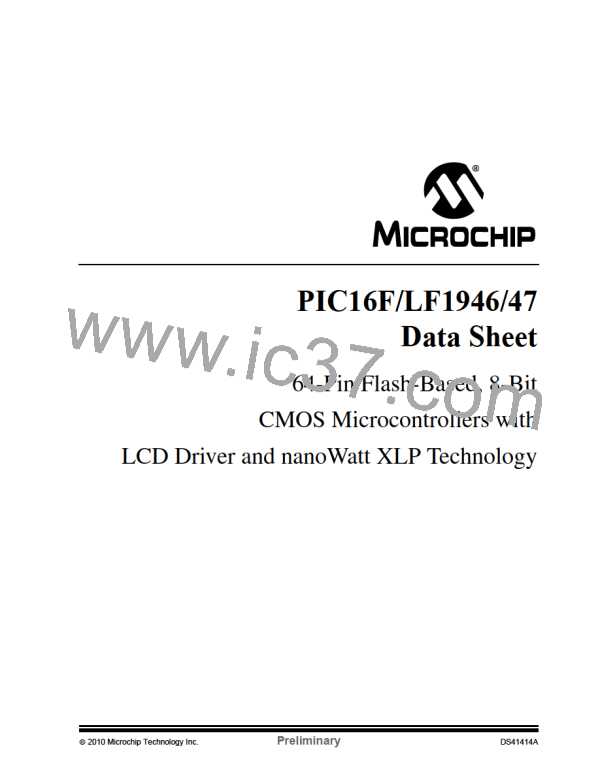PIC16F/LF1946/47
5.2.1.5
TIMER1 Oscillator
5.2.1.6
External RC Mode
The Timer1 Oscillator is a separate crystal oscillator
that is associated with the Timer1 peripheral. It is opti-
mized for timekeeping operations with a 32.768 kHz
crystal connected between the T1OSO and T1OSI
device pins.
The external Resistor-Capacitor (RC) modes support
the use of an external RC circuit. This allows the
designer maximum flexibility in frequency choice while
keeping costs to a minimum when clock accuracy is not
required.
The Timer1 Oscillator can be used as an alternate sys-
tem clock source and can be selected during run-time
using clock switching. Refer to Section 5.3 “Clock
Switching” for more information.
The RC circuit connects to OSC1. OSC2/CLKOUT is
available for general purpose I/O or CLKOUT. The
function of the OSC2/CLKOUT pin is determined by the
state of the CLKOUTEN bit in Configuration Word 1.
Figure 5-6 shows the external RC mode connections.
FIGURE 5-5:
QUARTZ CRYSTAL
OPERATION (TIMER1
OSCILLATOR)
FIGURE 5-6:
EXTERNAL RC MODES
VDD
PIC® MCU
PIC® MCU
REXT
OSC1/CLKIN
Internal
Clock
T1OSI
C1
To Internal
Logic
CEXT
VSS
32.768 kHz
Quartz
Crystal
OSC2/CLKOUT
(1)
FOSC/4 or I/O
T1OSO
C2
Recommended values: 10 k REXT 100 k, <3V
3 k REXT 100 k, 3-5V
CEXT > 20 pF, 2-5V
Note 1: Quartz crystal characteristics vary according
to type, package and manufacturer. The
user should consult the manufacturer data
sheets for specifications and recommended
application.
Note 1: Output depends upon CLKOUTEN bit of the
Configuration Word 1.
The RC oscillator frequency is a function of the supply
voltage, the resistor (REXT) and capacitor (CEXT) values
and the operating temperature. Other factors affecting
the oscillator frequency are:
2: Always verify oscillator performance over
the VDD and temperature range that is
expected for the application.
• threshold voltage variation
• component tolerances
• packaging variations in capacitance
3: For oscillator design assistance, reference
the following Microchip Applications Notes:
• AN826, “Crystal Oscillator Basics and
Crystal Selection for rfPIC® and PIC®
Devices” (DS00826)
The user also needs to take into account variation due
to tolerance of external RC components used.
• AN849, “Basic PIC® Oscillator Design”
(DS00849)
• AN943, “Practical PIC® Oscillator
Analysis and Design” (DS00943)
• AN949, “Making Your Oscillator Work”
(DS00949)
• TB097, “Interfacing a Micro Crystal
MS1V-T1K 32.768 kHz Tuning Fork
Crystal to a PIC16F690/SS” (DS91097)
• AN1288, “Design Practices for
Low-Power External Oscillators”
(DS01288)
DS41414A-page 62
Preliminary
2010 Microchip Technology Inc.

 MICROCHIP [ MICROCHIP ]
MICROCHIP [ MICROCHIP ]